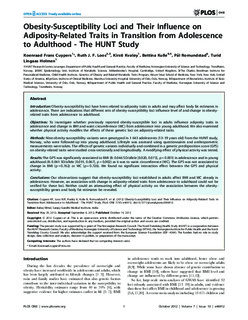| dc.contributor.author | Cuypers, Koenraad | |
| dc.contributor.author | Loos, Ruth J.F. | |
| dc.contributor.author | Kvaløy, Kirsti | |
| dc.contributor.author | Kulle, Bettina | |
| dc.contributor.author | Romundstad, Pål Richard | |
| dc.contributor.author | Holmen, Turid Lingaas | |
| dc.date.accessioned | 2015-10-30T14:21:14Z | |
| dc.date.accessioned | 2015-11-24T11:56:30Z | |
| dc.date.available | 2015-10-30T14:21:14Z | |
| dc.date.available | 2015-11-24T11:56:30Z | |
| dc.date.issued | 2012 | |
| dc.identifier.citation | PLoS ONE 2012, 7(10) | nb_NO |
| dc.identifier.issn | 1932-6203 | |
| dc.identifier.uri | http://hdl.handle.net/11250/2365440 | |
| dc.description.abstract | Introduction: Obesity-susceptibility loci have been related to adiposity traits in adults and may affect body fat estimates in
adolescence. There are indications that different sets of obesity-susceptibility loci influence level of and change in obesity-related
traits from adolescence to adulthood.
Objectives: To investigate whether previously reported obesity-susceptible loci in adults influence adiposity traits in
adolescence and change in BMI and waist circumference (WC) from adolescence into young adulthood. We also examined
whether physical activity modifies the effects of these genetic loci on adiposity-related traits.
Methods: Nine obesity-susceptibility variants were genotyped in 1 643 adolescents (13–19 years old) from the HUNT study,
Norway, who were followed-up into young adulthood. Lifestyle was assessed using questionnaires and anthropometric
measurements were taken. The effects of genetic variants individually and combined in a genetic predisposition score (GPS)
on obesity-related traits were studied cross-sectionally and longitudinally. A modifying effect of physical activity was tested.
Results: The GPS was significantly associated to BMI (B: 0.046 SD/allele [0.020, 0.073], p = 0.001) in adolescence and in young
adulthood (B: 0.041 SD/allele [0.015, 0.067], p = 0.002) as it was to waist circumference (WC). The GPS was not associated to
change in BMI (p = 0.762) or WC (p = 0.726). We found no significant interaction effect between the GPS and physical
activity.
Conclusions: Our observations suggest that obesity-susceptibility loci established in adults affect BMI and WC already in
adolescence. However, an association with change in adiposity-related traits from adolescence to adulthood could not be
verified for these loci. Neither could an attenuating effect of physical activity on the association between the obesity-susceptibility
genes and body fat estimates be revealed. | nb_NO |
| dc.language.iso | eng | nb_NO |
| dc.publisher | Public Library of Science | nb_NO |
| dc.title | Obesity-Susceptibility Loci and Their Influence on Adiposity-Related Traits in Transition from Adolescence to Adulthood - The HUNT Study | nb_NO |
| dc.type | Journal article | nb_NO |
| dc.type | Peer reviewed | en_GB |
| dc.date.updated | 2015-10-30T14:21:14Z | |
| dc.source.volume | 7 | nb_NO |
| dc.source.journal | PLoS ONE | nb_NO |
| dc.source.issue | 10 | nb_NO |
| dc.identifier.doi | 10.1371/journal.pone.0046912 | |
| dc.identifier.cristin | 974695 | |
| dc.description.localcode | © Cuypers et al. This is an open-access article distributed under the terms of the Creative Commons Attribution License, which permits unrestricted use, distribution, and reproduction in any medium, provided the original author and source are credited. | nb_NO |
